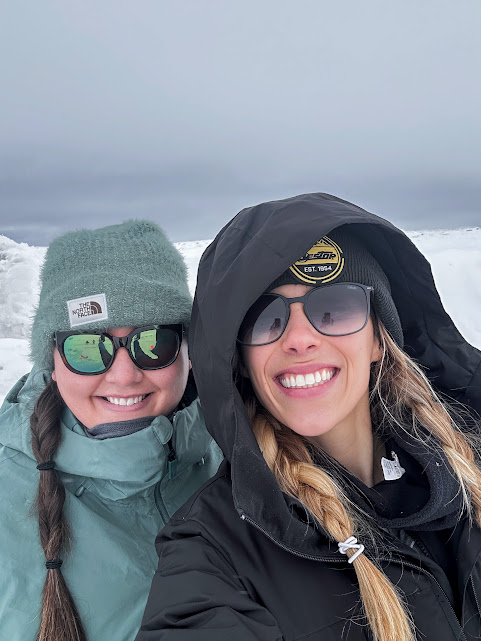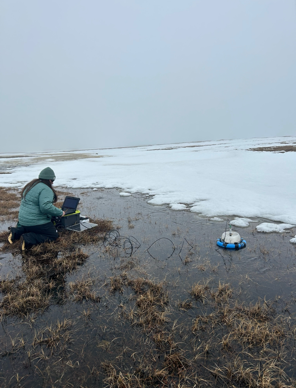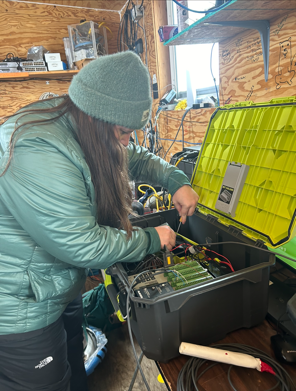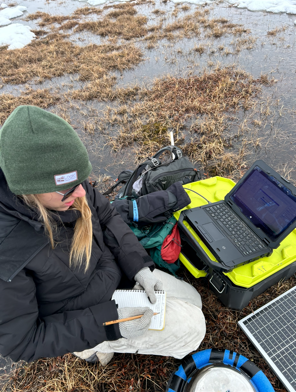An Unforgettable Adventure Begins

As a high school science teacher, the invitation to join Macall Hock on an expedition to study the effects of a warming Arctic ecosystem on stream carbon cycling in Utqiagvik, Alaska, felt like stepping into a thrilling adventure. The beauty of the Arctic wilderness was a sight to behold, but the harsh conditions quickly reminded me that this journey would test my limits. With our gear packed tightly in our backpacks, we ventured into the snow and ice, ready to uncover the secrets of the Arctic.
The Harsh Realities of Arctic Research



From the moment I set foot in Utqiagvik, the cold and snowy conditions became my constant companions. Trudging through the snow and ice was no easy feat. Each step was a battle against the biting wind and treacherous terrain. Yet despite the physical challenges, the importance of our mission kept us going. We were there to gather crucial data on snowmelt stream carbon cycling, which would help unravel the mysteries of how carbon fluxes impact the Arctic carbon balance in the face of climate change. This data is considered “low confidence” by IPCC due to its current lack of research data. As we held fast against the elements, it became apparent why this was not a highly researched aspect of carbon in freshwater streams. In addition to the inclement weather, challenges arose quickly due to nature’s impact on the very equipment we needed to collect such critical data. These new difficulties push adventurers to creative and innovative ends when alone in such remote places of the world. I recall the complexity of attempting to drive a water sensor deep into one of the Arctic streams using a thaw depth measuring stake – a seemingly simple task – made significantly more difficult by the permafrost. Even the simplest chores were made much more intense in the blustering wind and cold; and even more eventful while standing in the 1°C water! Every day was like a puzzle to make sure that our data and methods were accurate, and that we collected enough to help write the story of the carbon in these headwaters.
The Midnight Sun
One of the unique aspects of the region was the phenomenon of 24-hour daylight. The sun never set, casting a perpetual glow over the landscape. This endless daylight allowed us to extend our research hours, but it also required us to adapt in ways I hadn’t anticipated. Duct tape became my friend, as I had to seal the curtains shut over the window to try and trick my body into some sleep. Our sleep patterns shifted and we found ourselves working tirelessly, driven by the urgency of our mission to collect snowmelt data. The peak snowmelt happened within a 12-18 hour time frame as it was driven by the constant sunlight. Thus, we had to work fast and efficiently.
Challenges and Triumphs
Every day brought new challenges. Setting up equipment in freezing water temperatures, constant wind coming off of the sea ice, taking data with limited dexterity in our hands, and adapting to sudden weather changes tested our patience and resilience to new extremes. We constantly joked, “If it wasn’t for the wind, it might have been a nice day”. But with each obstacle we overcame, we felt a shared sense of triumph. The data we collected over a solid eight days was hard-earned; a testament to Macall’s dedication and the critical importance of her research. Understanding how warming temperatures affect these delicate ecosystems is essential for developing strategies to combat climate change and protect the Arctic.
The Nalukataq Experience

Amidst our scientific endeavors, we had the incredible opportunity to participate in the cultural celebration of Nalukataq. This traditional festival, marked by the joyous blanket toss and communal feasting, offered us a glimpse into the rich cultural heritage of the Iñupiat people. Witnessing the community come together through sustenance bowhead whale hunting (aġviq) to feed everyone was a profoundly moving experience. This festival is a year in the making as everything they use is harvested from the land or sea.
At the festival, different parts of the bowhead whale were served, including muktuk (the skin and blubber), maktak (more of the skin and blubber, but prepared differently), uunaalik (whale oil), and qaaktaq (dried whale meat). The caribou (tuttu) provided not only meat for the stew that was served, but the sinew was used to help stitch and tighten the skins that make up the whaling boats. The entire goose (niġliq) that was hunted was used in the soup for delicious flavor. Additionally, there was a dessert made from cloudberries (aqpik) that are native to this area.
The sense of unity and cooperation, where the success of the hunt meant nourishment for all, was something I will never forget. It truly showed the deep connection between the people and the land, a relationship that is essential to the survival and well-being of the community.

Polar STEAM: Bridging Science and Education
The insights gained from this expedition are not just numbers and data points; they are stories of resilience and discovery that I am excited to bring back to my students. Through Polar STEAM, an initiative that integrates the arts and sciences in polar research, I can share these experiences in a way that captivates and educates. Students can engage with real-world data, understand the importance of Arctic ecosystems, and develop a deeper appreciation for the challenges and rewards of scientific research. It’s about making science come alive, bridging the gap between theory and practice, and inspiring the next generation of scientists and environmentalists.
Inspiring Future Generations
As I reflect on our journey in Utqiagvik, I am struck by the profound impact it has had on me, both as a teacher and as a lifelong learner. The data we gathered is crucial for understanding the Arctic carbon balance and addressing climate change, but the experiences and stories are equally valuable. By sharing these tales of adventure, culture, and scientific discovery with my students, I hope to ignite their curiosity and passion for the natural world. Our time in the Arctic was a testament to the difficulties and rewards of studying in extreme environments. It’s a story of resilience, determination, and the relentless pursuit of knowledge—a story I am proud to pass on to my students, inspiring them to explore, learn, and protect our planet.



